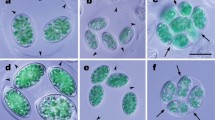Abstract
Structures which may establish cytoplasmic continuity between adjacent cells of filamentous cyanobacteria have been observed by freeze-fracture electron microscopy. They are visible in the septum region of the plasma membrane as pits on the E-face (EF) and corresponding protrusions on the P-face (PF). Between 100 and 250 of these structures, termed microplasmodesmata, were present between adjacent vegetative cells in all four strains of heterocyst-forming filamentous cyanobacteria, Anabaena cylindrica Lemm, A. variabilis (IUCC B377), A. variabilis Kütz. (ATCC 29413) and Nostoc muscorum, examined. Only 30–40 microplasmodesmata were observed between adjacent cells in two species, Phormidium luridum and Plectonema boryanum, that do not form heterocysts. The results suggest that in species that form heterocysts a greater degree of cytoplasmic continuity is established, presumably to facilitate the exchange of metabolites. In species capable of forming heterocysts, the number of microplasmodesmata per septum between two adjacent vegetative cells remained constant whether the filaments were grown in the presence of NH4 and lacked heteroxysts or under N2-fixing conditions and contained heterocysts. When a vegetative cell differentiates into a heterocyst, about 80% of the existing microplasmodesmata are destroyed as the poles of the cell become constricted into narrow necks leaving smaller areas of contact with the adjacent vegetative cells.
Similar content being viewed by others
References
Allen MB, Arnon DI (1955) Studies on nitrogen fixing blue-green algae: Growth and nitrogen fixation by Anabaena cylindrica Lemm. Plant Physiol 30:366–372
Allen MM (1968) Simple conditions for growth of unicellular blue-green algae on plates. J Phycol 4:1–4
Arnon DI, McSwain BD, Tsujimoto HY, Wada K (1974) Photochemical activity and components of membrane preparations from blue-green algae. I. Coexistence of two photosystems in relation to chlorophylla and removal of phycocyanin. Biochem Biophys Acta 357:231–245
Bisalputra T, Oakley BR, Walker DC, Shields CM (1975) Microtubular complexes in blue-green algae. Protoplasma 86:19–28
Branton D, Bullivant S, Gilula NB, Karnovsky MJ, Moor H, Muhlethaler K, Northcote DH, Packer L, Satir B, Satir P, Speth V, Staehelin LA, Steere RL, Weinstein RS (1975) Freeze-etching nomenclature. Science 190:54–56
Butler RD, Allsopp A (1972) Ultrastructural investigation in the Stigonemataceac (Cyanophyta). Arch Mikrobiol 82:283–299
Drews G (1959) Beiträge zur Kenntnis des phototaktischen Reaktionen der Cyanophyceen. Arch Protistenk 104:389–430
Giddings TH, Staehelin LA (1978) Plasma membrane architecture of Anabaena cylindrica: Occurrence of microplasmodesmata and changes associated with heterocyst development and the cell cycle. Cytobiol 16:235–249
Golecki JR, Drews G (1974) Zur Struktur der Blaualgen-Zellwand. Gefrierätzuntersuchungen an normalen und extrahierten Zellwänden von Anabaena variabilis. Cytobiol 8:213–227
Jost M (1965) Die Ultrastruktur von Oscillatoria rubescens DC. Arch Mikrobiol 50:211–245
Lamont HC (1969) Sacrificial cell death and trichome breakage in an oscillatorian blue-green alga: the role of murein. Arch Mikrobiol 69:237–259
Lang NJ, Fay P (1971) The heterocysts of blue-green algae. II. Details of ultrastructure. Proc Roy Soc Lond B 178:193–203
Metzner I (1953) Zur Chemie und zum submikroskopischen Aufbau der Zellwände, Scheiden und Gallerten von Cyanophyceen. Arch Mikrobiol 22:45–77
Pankratz HS, Bowen CC (1963) Cytology of blue-green algae. I. The Cells of Symploca muscorum. Amer J. Bot 50:387–399
Peat A, Whitton BA (1968) Vegetative cell structure in Anabaenopsis sp. Arch Mikrobiol 63:170–176
Wilcox M, Mitchinson GJ, Smith RJ (1973) Pattern formation in the blue-green alga Anabaena. II. Controlled proheterocyst regression. J Cell Sci 13:637–649
Wildon DC, Mercer FV (1963a) The ultrastructure of the heterocyst and akinete of blue-green algae. Arch Mikrobiol 47:19–31
Wildon DC, Mercer FV (1963b) The ultrastructure of the vegetative cell of blue-green algae. Aust J Biol Sci 16:585–596
Wolk CP (1968) Movement of carbon from vegetative cells to heterocysts in Anabaena cylindrica. J Bacteriol 96:2138–2143
Wolk CP (1973) Physiology and cytological chemistry of blue-green algae. Bacterial Revs 37:32–101
Wolk CP, Austin SM, Bortins J, Galonsky A (1974) Autoradiographic localization of 13N after fixation of 13N-labelled nitrogen gas by a heterocyst-forming blue-green alga. J Cell Biol 61:440–453
Author information
Authors and Affiliations
Rights and permissions
About this article
Cite this article
Giddings, T.H., Staehelin, L.A. Observation of microplasmodesmata in both heterocyst-forming and non-heterocyst forming filamentous cyanobacteria by freeze-fracture electron microscopy. Arch. Microbiol. 129, 295–298 (1981). https://doi.org/10.1007/BF00414700
Received:
Accepted:
Issue Date:
DOI: https://doi.org/10.1007/BF00414700




